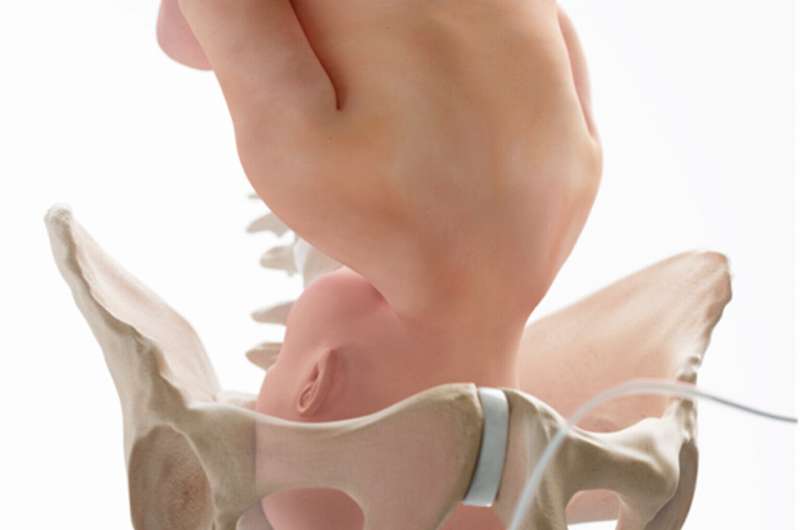This article has been reviewed according to Science X's editorial process and policies. Editors have highlighted the following attributes while ensuring the content's credibility:
fact-checked
trusted source
proofread
Cesarean birth injury rates have risen for moms and babies, but training and new device could change that

More than 34% of women in Australia have a cesarean birth, and a significant proportion of these happen in late labor when the fetal head is deep in the mother's pelvis and can be impacted which makes delivering a baby challenging and poses serious risks to both the mother and the baby.
It's estimated the baby's head is wedged, known as impacted fetal head (IFH) in around 10% of all emergency cesarean births (CB). This makes it difficult for the doctor to get their hand below the baby's head to deliver it, which leads to longer delivery times.
Recent statistics show that while the majority of babies born following IFH sustain minor damage, 2% of these infants die or suffer serious injuries with lifelong consequences. The NHS Resolution report in the U.K. states that 9% of avoidable brain injuries at birth are caused by impacted fetal head (IFH).
Complications for the mother include increased blood loss, an increased risk of infection, bladder and urinary tract damage, uterine tears that require repair and may cause issues in subsequent pregnancies, or even a hysterectomy. While complications for the baby include lacerations and bruising to the head and face, skull fractures, and hemorrhages, there have also been reports of eye injuries.
A Scientific Impact Paper published in BJOG: An International Journal of Obstetrics & Gynaecology by the Royal College of Obstetricians & Gynecologists in the U.K. and Professor Annette Briley at Flinders University has reported a significant rise in cases of IFH injuries in recent years, with maternity staff implementing varied approaches and no consensus regarding the definition or training regarding management to help deliver the baby during CB.
Approaches to managing this obstetric emergency include having an assistant push the baby's head up during birth, delivering the baby feet first, using an inflatable balloon device (Fetal Pillow) designed to elevate the baby's head, and administering medication to relax the mother's womb.
However, this scientific impact paper reviewed the available evidence, concluding there is currently no consensus on the best approach for these risky cases.
Various maneuvers and some devices have been introduced to help with the delivery of the baby in this situation, but to date there is no consensus on which is best for mothers and babies or the training required for staff managing this emergency situation.
Most commonly, an assistant is asked to push up from below, although some evidence suggests reverse breech extraction may be associated with better outcomes. A U.K.-wide survey reported that more than half of obstetric registrars did not feel confident performing reverse breech extraction, and fewer than one in 10 are familiar with the Patwardhan technique.
"The aim of this scientific impact paper was to examine all the current available evidence regarding different maneuvers and devices currently in use to manage IFH, with the results integrated into the findings of a systematic review commissioned by the National Guideline Alliance (U.K.)," says research co-author and midwife at Flinders University, Dr. Annette Briley.
The researchers say key steps need to be taken to improve standards:
- High-quality adequately powered RCTs comparing techniques to manage and prevent IFH are required. (Those currently available have significant weaknesses.)
- A universally accepted definition of IFH would facilitate future research and education.
- Women and their partners need to inform research around the language and management of IFH.
- The development and implementation of an evidence-based multi-professional educational package would lead to consistent management of this obstetric emergency.
- More research is required around the efficacy and cost-effectiveness of the Fetal Pillow
Dr. Briley says the data clearly shows that there has been a significant rise in cesarean sections in late labor and associated cases of IFH-related injuries in recent years, and further education is needed to develop consistent management of this obstetric emergency.
"We've reviewed the existing evidence on strategies to identify, prevent, and manage the IFH during births to provide guidance and recommendations that improve outcomes for mothers and babies when this potentially serious complication occurs. It's essential that clinicians use the best evidence to inform care for women and babies, including the optimal techniques to reduce the potentially devastating complications associated with IFH," says Briley.
Dr. Briley is also part of a research team developing and evaluating the Tydeman tube, an innovative single-use, hollow silicone tube inserted to elevate the baby's head. Its designed to minimize applied pressure to the head and reduce any suction effect once access has been achieved.
"A minimal number of Tydeman Tubes have been used clinically; further research in a clinical setting, compared with appropriately trained and executed manual disimpaction, is required to investigate its efficacy and safety before use," Briley says.
More information: Katie Cornthwaite et al, Management of Impacted Fetal Head at Caesarean Birth, BJOG: An International Journal of Obstetrics & Gynaecology (2023). DOI: 10.1111/1471-0528.17534


















